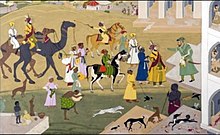Capture of Sambhaji
This article does not have any categories. Please add a category so that it will be placed in a dynamic list with other articles like it. (December 2024) |
A Millitary engagement between Marathas under Sambhaji I and Mughals under Muqqrab Khan and Ganoji Shirke in which Marathas were defeated resulting in death of Maloji Ghorpade and Raiba Malusare as well as capture and execution of Sambhaji I and Kavi Kalash.[1][2][3]
| Skirmish at Sangameshwar | |||||||
|---|---|---|---|---|---|---|---|
| Part of Deccan Wars | |||||||
 Sambhuji captured by Mughal forces under Muqqrab Khan and Ganoji Shirke | |||||||
| |||||||
| Belligerents | |||||||
| Mughal Empire | Maratha Empire | ||||||
| Commanders and leaders | |||||||
|
Muqqrab Khan Ganoji Shirke |
Sambhaji I (POW) Kavi Kalash (POW) Maloji Ghorpade † Raiba Malusare † | ||||||
| Strength | |||||||
| 8000 | 150 | ||||||
Battle
changeWhile Aurangzeb was besieging Golconda and Bijapur, Sambhaji observed from Panhala. After capturing these forts, Aurangzeb deployed Sarja Khan, a seasoned general, to the Deccan. In December 1687, the Marathas, led by Hambirrao Mohite, defeated the Mughals at the Battle of Wai, though Mohite was killed.[4] Following the battle, Sambhaji's forces weakened, and his movements were betrayed by Soyarabai and the Shirkes to the Mughals. Sambhaji was eventually caught by Mughal commander Muqarrab Khan supported by Ganoji Shirke after a defeat at Samgamneshwar on 1 February 1689.[5] He was captured along with his minister Kavi Kalash and 25 officers. Aurangzeb, pleased with the capture, renamed Akluj to Asadnagar.[6]
Aftermath
changeKavi Kalash and Sambhaji, captured by the Mughals, were humiliated and paraded through the Mughal camps before being presented to Aurangzeb. He offered to spare Sambhaji’s life if he surrendered his forts, disclosed his treasuries, and revealed Mughal officers aiding the Marathas, even offering him conversion to Islam. However, Sambhaji insulted Aurangzeb and Muhammad, leading the Ulema to sentence him to death. When Sambhaji mocked Aurangzeb by requesting his daughter for conversion, he was tortured, blinded with red-hot irons, and beheaded on March 21, 1689, at Koregaon, marking the end of resistance in the region.[7][8]
References
change- ↑ Kulkarni, G. T. (1983). The Mughal-Maratha Relations: Twenty Five Fateful Years, 1682-1707. Department of History, Deccan College Post-Graduate Research Institute. p. 74.
- ↑ Richards, John F. (1993). The Mughal Empire. Cambridge University Press. p. 223. ISBN 978-0-521-56603-2.
- ↑ Jaisingrao Pawar. Chhatrapati Rajaram And The Maratha State.
- ↑ Karandikar, Shivaram Laxman (1969). The Rise and Fall of the Maratha Power. Sitabai Shivram Karandikar. pp. 307–310.
- ↑ Joshi, Pandit Shankar (1980). Chhatrapati Sambhaji, 1657-1689 A.D. S. Chand. p. 241.
- ↑ Mehta, Jaswant Lal (2005-01-01). Advanced Study in the History of Modern India 1707-1813. Sterling Publishers Pvt. Ltd. pp. 49–50. ISBN 978-1-932705-54-6.
- ↑ Johnston, Harry (1986). The Great Pioneer in India, Ceylon, Bhutan & Tibet. Mittal Publications. p. 252.
- ↑ Pāṭīla, Śālinī (1987). Maharani Tarabai of Kolhapur, C. 1675-1761 A.D. S. Chand & Company. pp. 46–48. ISBN 978-81-219-0269-4.